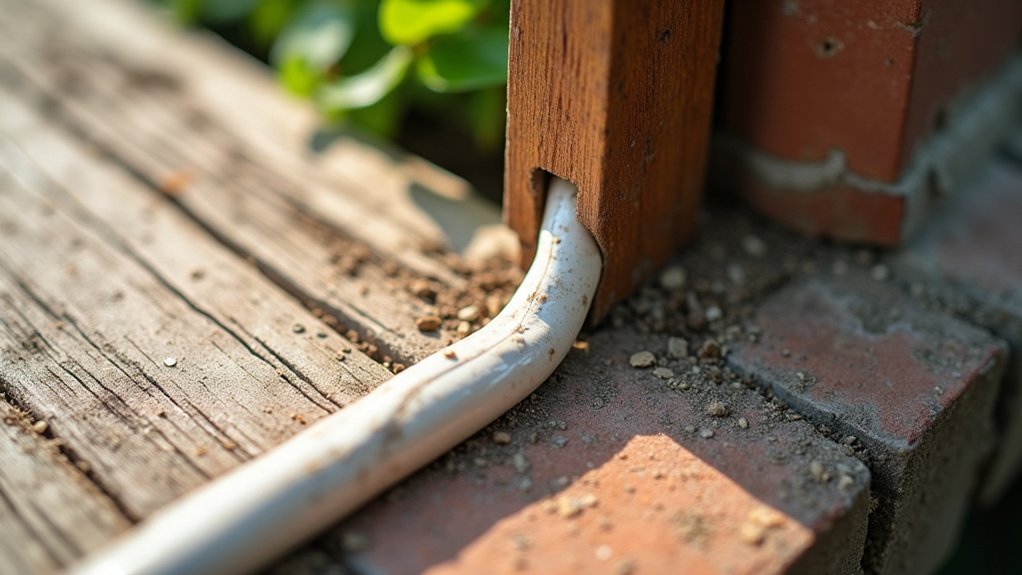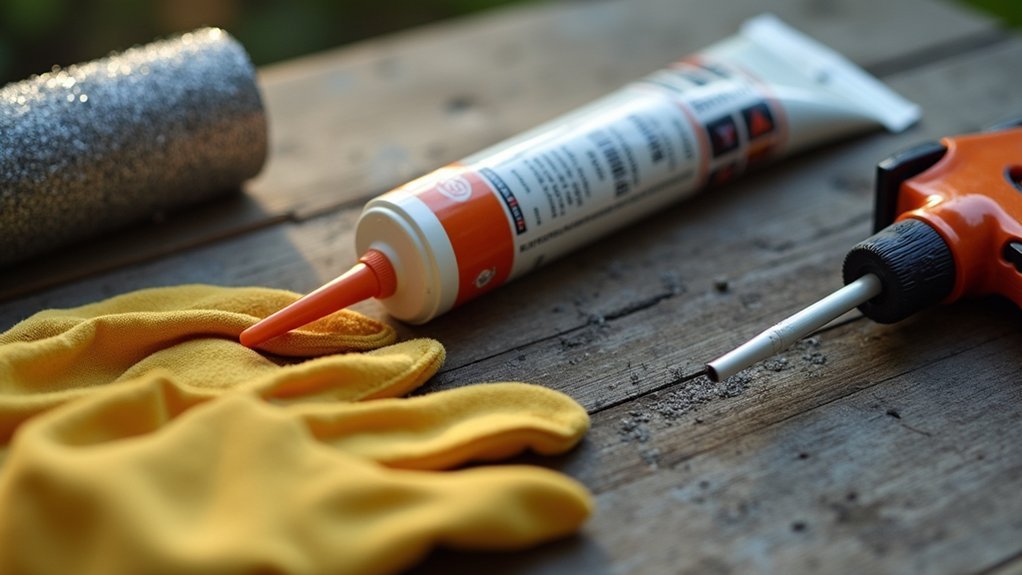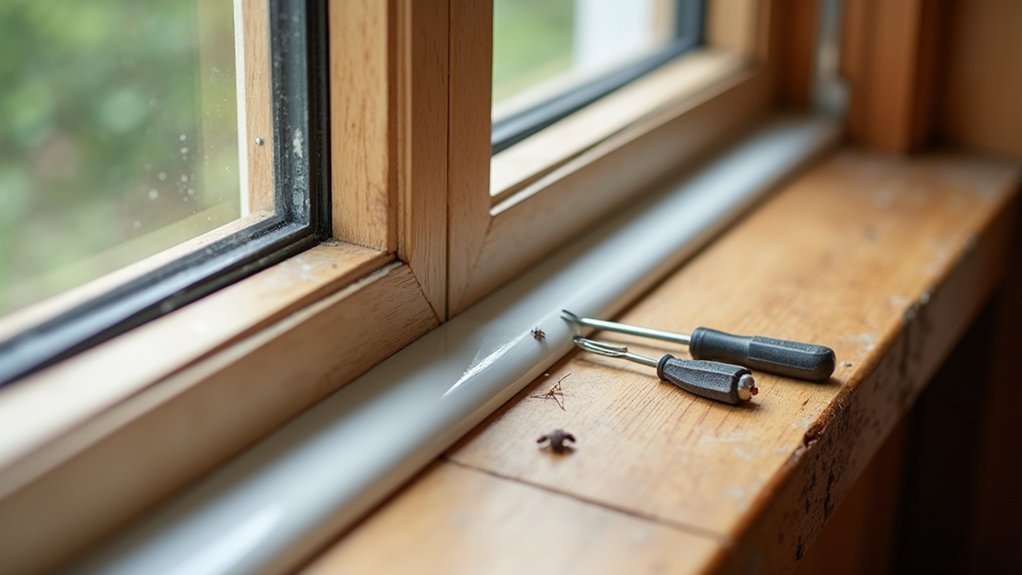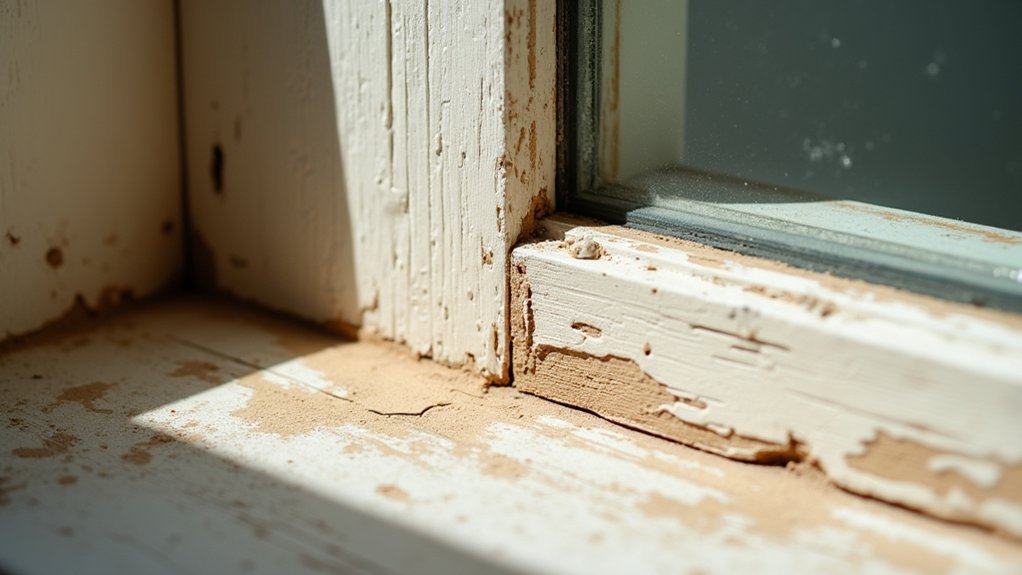Effective rodent-proofing requires thorough caulking of all entry points, as mice can squeeze through dime-sized openings. Focus on sealing window frames, door gaps, utility penetrations, and foundation cracks with silicone or polyurethane caulk. Reinforce larger openings with steel wool before caulking for added protection. Clean surfaces thoroughly before application and inspect your seals bi-annually, especially after winter. Proper material selection and application techniques make the difference between a vulnerable home and a rodent-proof fortress.
Seal Homes Tight: Expert Rodent-Proofing Caulking Methods

When it comes to keeping unwanted rodent visitors at bay, proper caulking serves as your first line of defense. Mice can squeeze through openings as small as a dime, while rats need only a quarter-sized gap to invade your home.
That’s why thorough caulking of entry points is essential for effective rodent-proofing.
Choose high-quality silicone or acrylic latex caulk for durability and moisture resistance. These materials maintain flexibility over time, ensuring gaps stay sealed despite environmental changes.
For larger openings, apply expanding foam sealant, which creates a dense barrier rodents can’t chew through.
Don’t forget to regularly inspect areas around windows, doors, and utility lines where seals might deteriorate.
Understanding Rodent Entry Points: Where to Focus Your Caulking Efforts
Effective rodent-proofing begins with identifying the vulnerable areas where these persistent pests infiltrate your home.
Remember that mice can squeeze through dime-sized openings, while rats need only quarter-sized gaps to gain entry.
Focus your caulking efforts on windows and door frames where weatherstripping has deteriorated.
Don’t overlook utility penetrations—pipes and electrical lines create perfect rodent highways into your home. These openings require special attention with steel wool and caulk for proper sealing.
Your home’s foundation and roofline are critical rodent-proofing zones.
Inspect for cracks in the foundation and gaps around chimneys or loose shingles.
Finally, secure all vents in attics and basements with rodent-proof mesh, as these often-forgotten areas provide easy access for unwanted visitors.
Essential Tools and Materials for Effective Rodent-Proofing

Three core materials form the foundation of any successful rodent-proofing project: high-quality caulk, steel wool, and appropriate application tools.
The foundation of effective rodent-proofing lies in three essential elements: quality caulk, durable steel wool, and proper tools.
You’ll need to assemble these essential items before tackling any rodent entry points in your home:
- A quality caulking gun for precise application of sealant into cracks and crevices
- Silicone or polyurethane caulk that remains flexible after drying
- Steel wool to stuff into gaps before applying caulk, creating a barrier rodents can’t chew through
- Expanding foam insulation for filling larger voids where caulk alone isn’t sufficient
- Stainless steel mesh or galvanized metal for high-traffic areas requiring extra durability
Remember that combining materials often creates the most effective barriers—pack steel wool into gaps first, then seal with caulk for maximum protection.
Selecting the Right Type of Caulk for Different Home Surfaces
Choosing the right caulk for your home’s surfaces is critical for effective rodent-proofing. Silicone options work best on non-porous materials like glass and metal entry points, while polyurethane formulations offer superior outdoor protection.
When sealing wooden areas, you’ll need to apply wood-specific techniques such as thoroughly cleaning the surface, priming if necessary, and using a flexible caulk that can accommodate wood’s natural expansion and contraction.
Your selection should always factor in the surface material, environmental exposure, and the specific rodent pressure in your area to guarantee lasting protection.
Silicone vs. Polyurethane Options
Homeowners face a critical decision when selecting caulk for rodent-proofing: silicone or polyurethane. Your choice depends on the specific application area and surface type when you rodent-proof your home.
- Silicone caulk offers superior flexibility and waterproofing for bathrooms, kitchens, and non-porous surfaces like glass and metal.
- Polyurethane caulk provides exceptional durability for outdoor applications and extreme weather conditions.
- For wood surfaces, polyurethane’s ability to expand and contract with the material prevents future entry points.
- Silicone’s lower VOC content makes it safer for indoor air quality concerns.
- Consider a combined approach—silicone for non-porous surfaces and polyurethane for porous materials—for thorough protection.
Understanding these differences guarantees you’ll create effective barriers that prevent rodents from entering your home through small gaps and cracks.
Metal Entry Point Protection
Metal entry points represent one of the most overlooked vulnerabilities in rodent-proofing your home. When sealing these areas, choosing the right caulk is vital for effective protection.
For aluminum or galvanized steel surfaces, silicone-based caulks provide superior adhesion and flexible, waterproof seals that withstand temperature fluctuations.
When dealing with metal-to-masonry connections, opt for polyurethane caulk, which offers exceptional durability against harsh weather conditions.
If you’re sealing gaps where metal meets wood, such as around pipes or vents, paintable acrylic latex caulk allows for a seamless finish that blends with your home’s aesthetic.
For maximum rodent proofing effectiveness, consider specialized caulks containing rodent-repelling agents that both seal metal entry points and deter pests.
Always verify material compatibility on the manufacturer’s specifications before application to guarantee long-lasting protection.
Wood-Specific Caulking Techniques
Wooden surfaces in homes present unique challenges for rodent-proofing due to their tendency to expand, contract, and warp with temperature and humidity changes.
To effectively seal gaps in wood surfaces, you’ll need both the right caulk and proper application techniques.
- Choose paintable acrylic latex caulk for interior wood surfaces that you’ll want to paint later.
- Select silicone-based caulk for outdoor wooden areas where moisture resistance is vital.
- Clean and thoroughly dry all wood surfaces before applying caulk to guarantee maximum adhesion.
- Use a caulking gun to apply an even, continuous bead that completely fills gaps.
- Regularly inspect wooden areas and replace deteriorating caulk to maintain your rodent barrier.
Remember that properly sealed wood surfaces not only prevent rodent entry but also improve your home’s energy efficiency and appearance.
Foundation Sealing Techniques to Block Ground-Level Access
Your home’s foundation offers multiple entry points for rodents that you’ll need to address through specific sealing techniques.
For concrete cracks, apply elastomeric caulk in thin layers, working the material deep into fractures, while damaged mortar joints require specialized masonry repair caulk pressed firmly into deteriorated areas.
Implement a thorough perimeter caulking strategy by creating a continuous seal around the foundation’s exterior edge, paying special attention to utility penetrations and expansion joints where rodents commonly attempt entry.
Concrete Crack Filling Methods
Three essential foundation sealing techniques can prevent rodents from infiltrating your home through ground-level cracks. To effectively seal cracks and prevent rodents from entering, you’ll need high-quality concrete crack filler specifically designed for structural integrity.
- Clean cracks thoroughly, removing all debris and moisture before application.
- Apply filler deeply into cracks, guaranteeing complete penetration to the surface level.
- Use hydraulic cement for larger cracks—it expands while curing for superior sealing.
- Ascertain the filler creates a solid barrier that mice and rats can’t chew through.
- Inspect your foundation regularly and reapply filler to maintain rodent-proofing effectiveness.
Proper application creates an impenetrable barrier that seals cracks completely, blocking even the smallest rodents from accessing your home through foundation weaknesses.
Mortar Joint Repair
Deteriorating mortar joints between foundation bricks or stones create ideal entry points for determined rodents seeking warmth and food sources inside your home.
Regular inspection of these joints is vital, as they naturally deteriorate over time, compromising your home’s rodent-proof barrier.
When performing mortar joint repair, select a high-quality, flexible mortar mix that guarantees proper adhesion and can withstand environmental changes.
Carefully remove damaged mortar, clean the area thoroughly, and apply the new mixture, pressing firmly into all cracks and gaps.
For maximum protection, apply a waterproof sealant after the mortar has cured completely.
This additional barrier prevents moisture accumulation that attracts rodents and causes further deterioration.
Properly repaired mortar joints eliminate rodent entry points and form an essential component of your thorough foundation rodent-proofing strategy.
Perimeter Caulking Strategies
Creating an impenetrable barrier around your foundation requires strategic perimeter caulking to eliminate ground-level access points that rodents exploit.
Focus on thorough seal gaps techniques to block even the smallest entry opportunities.
- Apply high-quality silicone or polyurethane caulk to any cracks or gaps exceeding 1/4 inch
- Reinforce caulking with stainless steel or copper mesh for areas vulnerable to gnawing
- Install metal flashing around exterior wall bases for an additional protective layer
- Pay special attention to utility line entry points, which are common rodent access routes
- Establish a regular inspection schedule to identify and seal new cracks before they become problematic
Weather-Resistant Caulking Methods for Exterior Walls
While your home’s exterior walls serve as the first line of defense against the elements, they’re also potential entry points for unwanted rodent visitors if not properly sealed.
Weather-resistant caulking methods offer effective protection by creating a durable seal against moisture and temperature fluctuations.
Choose silicone or polyurethane caulk for exterior applications—these can withstand extreme temperatures from -40°F to 200°F.
Before applying, thoroughly clean and dry all surfaces to guarantee proper adhesion. Apply a smooth, continuous bead that completely fills gaps and cracks.
Remember that even the best caulking job requires maintenance. Inspect your exterior walls regularly and reapply caulk every few years as weather exposure gradually degrades the material.
This preventive approach helps maintain a rodent-proof barrier and prevent entry points that mice and rats might otherwise exploit.
Sealing Window Frames and Sills Against Gnawing Pests

Windows represent prime targets for rodent invasion because their frames and sills often develop small gaps that go unnoticed by homeowners. To seal homes tight against these persistent pests, you’ll need high-quality silicone or polyurethane caulk that resists rodent gnawing.
Don’t overlook window gaps—they’re rodent highways into your home that quality caulk can effectively block.
- Apply caulk to fill even tiny 1/4-inch gaps—that’s all mice need to enter.
- Don’t forget to check where window frames meet exterior walls—common entry points.
- Combine caulking with weather stripping around sashes for enhanced protection.
- Regularly inspect your work for deterioration, especially after harsh weather.
- Remember to address gaps around doors using the same thorough approach.
Maintaining intact window screens provides an additional defense layer while preserving ventilation.
Unlike temporary solutions, proper caulking creates a durable barrier that prevents costly infestations before they begin.
Door Frame and Threshold Caulking Strategies
Door frames and thresholds represent the most commonly exploited entry points for determined rodents seeking shelter in your home. To prevent infestations, apply high-quality silicone or acrylic latex caulk to seal gaps around door frames, creating a flexible yet durable barrier against pests.
| Caulking Area | Material | Gap Size | Protection Level |
|---|---|---|---|
| Frame Corners | Silicone | <1/8 inch | High |
| Along Jambs | Acrylic Latex | 1/8-1/4 inch | Medium-High |
| Under Threshold | Metal-Reinforced | >1/4 inch | Maximum |
| Weather Strip Edge | Flexible Sealant | Variable | Adaptive |
Install door sweeps with a height of at least 1/4 inch at exterior doorways. Consider adding metal flashing around wooden frames—rodents can’t chew through it. Remember to regularly inspect your work, as damaged seals create new entry opportunities for mice that can squeeze through dime-sized openings.
Utility Penetration Points: Sealing Pipes and Wires
Plumbing, electrical, and HVAC penetrations represent critical vulnerabilities in your home’s rodent defense system.
These utility penetration points need special attention as mice can squeeze through gaps as small as a quarter-inch.
- Examine your home’s exterior where pipes and wires enter, looking for spaces that could allow rodent entry.
- Apply expanding foam or silicone sealant around smaller gaps to create a durable barrier.
- Reinforce larger openings with stainless steel mesh before sealing for extra protection.
- Check sealed areas regularly for deterioration or new gaps that may develop.
- Remember that properly sealed utility points also improve your home’s energy efficiency by preventing drafts.
Don’t underestimate these often-overlooked entry points—sealing gaps around utilities is among the most effective ways to rodent-proof your home.
Attic and Roof Junction Caulking for Complete Protection
Attic and roof junctions offer another set of vulnerable entry points that rodents frequently exploit. These crafty creatures can squeeze through openings as small as 1/4 inch—about the size of a dime—making thorough caulking essential to prevent rodent access.
When applying caulk, pay special attention to areas around roof vents, chimneys, and edges where the roof meets walls. Choose high-quality, weather-resistant silicone or polyurethane products that remain flexible and adhere well to wood, metal, and concrete surfaces.
Don’t forget to conduct regular inspections of these areas to identify and seal gaps that may develop over time. Your diligence won’t only keep unwanted pests out but also improve your home’s energy efficiency by eliminating drafts and reducing heat loss.
Garage and Outbuilding Specific Sealing Methods
The vulnerability of garages and outbuildings makes them prime targets for determined rodents seeking shelter, food, or a breeding ground.
These spaces require specific sealing methods to prevent unwanted visitors.
- Install weatherstripping along garage doors to eliminate gaps that provide potential entry points.
- Apply metal flashing at the base of garage doors for a gnaw-proof barrier.
- Seal gaps around utility lines and pipes with caulk, steel wool, or expanding foam.
- Cover vents and exhaust openings with rodent-proof mesh for protection without sacrificing ventilation.
- Clear debris and vegetation around the perimeter to eliminate hiding spots.
Remember to regularly inspect your garage for new potential entry points.
Even small gaps can become highways for rodents, so maintaining vigilance guarantees your sealing efforts remain effective year-round.
Combining Steel Wool With Caulk for Enhanced Barriers
When standard caulking fails to repel determined rodents, combining steel wool with caulk creates an impenetrable defense system that few pests can overcome. This powerful combination works because rodents can’t chew through the tough steel fibers embedded in the caulk.
To create an effective rodent-proof barrier, first apply caulk into the gap, then press steel wool firmly into the material while it’s still wet. This non-toxic solution is ideal for families concerned about chemical exposure.
| Application Area | Steel Wool Type | Caulk Type |
|---|---|---|
| Indoor gaps | Fine grade | Silicone |
| Exterior holes | Medium grade | Exterior |
| Foundation | Coarse grade | Concrete |
| Utility entries | Medium grade | Waterproof |
| Small cracks | Extra fine | Flexible |
Remember to inspect these barriers regularly, as any compromise could allow rodents to enter your home.
Seasonal Inspection and Maintenance of Caulked Areas
Winter’s freezing temperatures can cause caulked seals to contract and crack, creating potential entry points for opportunistic rodents seeking shelter.
You’ll need to inspect your home’s exterior caulking once temperatures rise in spring, focusing particularly on areas around windows, doors, and utility entry points.
Scheduling a bi-annual maintenance routine that includes removing damaged caulking and applying fresh sealant will maintain your home’s rodent-proof integrity throughout the changing seasons.
Winter Weather Impacts
As temperatures plummet and harsh conditions set in, your home’s caulking faces some of its toughest challenges.
Winter weather can cause significant deterioration of your seals, creating perfect rodent entry points when you least want unwelcome visitors.
- Cold temperatures cause caulk to contract and crack, creating gaps rodents can exploit
- Moisture from snow and ice further damages compromised seals
- Your heating costs may increase by up to 20% with inadequate caulking
- Rodents actively seek warm shelter during winter, making your home a prime target
- Weather-resistant caulk provides superior protection against harsh elements
Don’t wait until you spot a furry intruder—inspect your caulking twice yearly, especially before winter arrives.
Quality weather-resistant caulk represents a small investment that delivers significant returns in both pest prevention and energy savings.
Spring Maintenance Schedule
Spring signals the perfect time to review your home’s rodent defense system. After winter’s harsh conditions, it’s essential to inspect all caulked areas for damage that could create potential rodent entry points.
| Inspection Area | What to Look For | Action Required |
|---|---|---|
| Windows | Cracking, peeling | Reapply weather-resistant caulk |
| Doors | Gaps, wear | Seal completely with quality caulk |
| Foundation | Winter damage | Focus on deteriorated sections |
| Utility openings | Compromised seals | Prioritize these common entry points |
| Exterior joints | Moisture damage, mold | Replace affected caulking |
Don’t wait until you’ve spotted signs of rodent infestations. By conducting thorough seasonal inspections and immediately addressing compromised caulked areas, you’ll maintain your home’s defensive barrier. Pay special attention to utility openings where rodents commonly attempt entry, and you’ll stay ahead of potential problems.
Common Caulking Mistakes That Leave Homes Vulnerable
Despite their best intentions, homeowners often make critical caulking errors that practically roll out the welcome mat for rodents.
When you’re trying to rodent-proof your home, avoiding these common mistakes can make all the difference in preventing unwanted visitors.
- Choosing the wrong caulking material like latex instead of silicone or polyurethane that better resist rodent entry
- Failing to properly clean surfaces before application, resulting in poor adhesion
- Neglecting to fill gaps smaller than 1/4 inch that mice can easily squeeze through
- Applying caulk too thinly or unevenly, creating weak points that crack over time
- Skipping regular inspections of caulked areas, allowing deterioration to create new entry points
Don’t underestimate these seemingly minor oversights—they’re often the exact vulnerabilities rodents exploit.
Frequently Asked Questions
What Is the Best Caulk to Keep Rodents Out?
You’ll find mouse-proof silicone sealant is your best option for keeping rodents out. It’s non-toxic and resistant to gnawing. Polyurethane caulk also works well, offering flexibility with temperature changes while maintaining tight seals.
Can Mice Chew Through 100% Silicone?
While mice can technically chew through 100% silicone, they’re unlikely to persist. You’ll find it’s one of your best defenses as its elastic texture discourages gnawing and maintains integrity over time.
How to Seal Door Gaps to Prevent Mice?
To seal door gaps against mice, install door sweeps on bottoms, apply weather stripping around frames, and use silicone caulk for cracks. You’ll need to make certain gaps are smaller than 1/4 inch to prevent entry.
Can Rodents Chew Through Caulk?
Yes, rodents can chew through standard caulk. You’ll need to combine it with steel wool or metal mesh for effective protection. Consider using specialized rodent-resistant silicone sealants and inspect regularly for damage.
In Summary
Properly caulking your home is your best defense against unwanted rodent intruders. You’ll save time and money by doing it right the first time. Don’t forget to combine different materials like steel wool with quality caulk for maximum protection. Stay vigilant with seasonal inspections and you’ll keep these pests at bay year-round. Your home deserves this simple but effective protection.





Leave a Reply